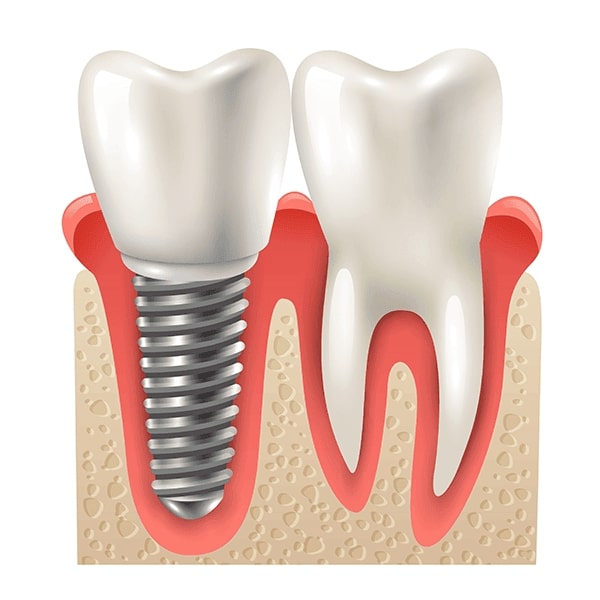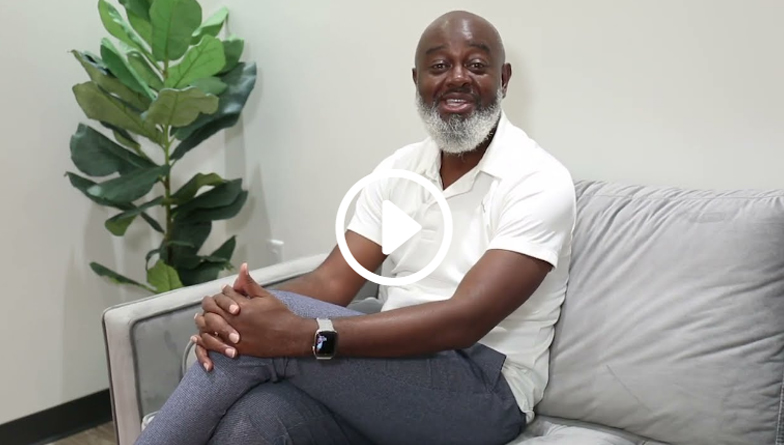Single Tooth Implants Near You
Every one of our teeth contributes to the structure and function of our smiles. So, when one is missing, it can lead to issues when eating and speaking. Bacteria can accumulate in this space, compromising the health of your gum tissue and jawbone.
At Lanier Valley Dentistry, we specialize in implant dentistry services. If you’re looking to learn more about acquiring single tooth implants in Dacula, please reach out today. We’ll put you in touch with Dr. Lentz, who will gladly assist you with this treatment.
What are
Single Tooth Implants?
A dental implant is a prosthetic designed to replace a missing or extracted tooth, including its roots. The device is surgically drilled into your jaw. Over several months, it will fuse with your bone. This progress is known as osseointegration, and once it’s completed, you’ll be left with a strong oral foundation.
When you visit Lanier Valley, Dr. Lentz will answer any questions you have about dental implantation, including explaining each component of the implant itself:
- Implant screw — The screw is frequently designed from titanium or zirconia, two biocompatible materials that will not cause any irritation or swelling to your socket. This is the piece that bonds with your jaw material.
- Abutment — The abutment is the small connecting piece that fastens the screw to the prosthetic that sits on top. Alongside titanium, gold and porcelain can also be used to fabricate this component.
- Crown — A cap (or crown) is placed overtop the screw and abutment, allowing the entire implant to blend in with the rest of your smile. Dr. Lentz will work with you to choose the material you are happiest with, and then impressions are made so that the crown fits you perfectly. Options include gold, zirconia, or porcelain, which is the most popular.

What is the
Process Like?
Visiting any dentist near you to acquire a single tooth implant is a process that does require some patience, but it is a good investment for your oral health once it is finished. A dental implant can last nearly a lifetime if you practice good hygiene habits. Booking routine cleanings and checkups with Dr. Lentz, our dentist in Dacula, will ensure that your implant remains in good condition.
- Bone Examination. Dr. Lentz will evaluate your jawbone; it must be healthy enough to withstand implant installation. If not, he may recommend undergoing a bone graft before receiving the implant.
- Implant Placement. This process is surgical. Local anesthesia is provided to numb the area of your mouth that requires care, preventing you from feeling pain while Dr. Lentz works. The implant is drilled in place. Once this is done, your mouth requires at least 3-6 months to fully heal.
- Abutment Placement. When Dr. Lentz examines your mouth and determines that the tissue and bone have fully healed, the abutment is placed next. A temporary crown is added over the top.
- Permanent Crown. Attaching the permanent crown is the final step. It takes a few weeks to be created to your specifications at a dental laboratory. Dr. Lentz will cement it in position and then check that it does not alter your bite pattern.
You can treat your single tooth implant just as you would your normal tooth. You still need to prioritize your hygiene in between visit.
Come into Lanier Valley Dentistry for Quality Implant Care
Are you curious to learn more about acquiring single tooth implants near you? Contact our local dental practice. Our skilled team, led by Dr. Lentz, is ready to meet with you and talk about your oral health. You are family to us, and we will ensure you receive the treatment you deserve. Please call us or stop by our location at 3635 Braselton Hwy today.
Enhance Your Smile with Single Tooth Implants
Embark on a journey to restore your confidence and oral health with Lanier Valley Dentistry’s single-tooth implant services. Our commitment to excellence and patient-centric care ensures a seamless experience from consultation to the final radiant smile.
Experience the unparalleled expertise of our dental professionals, who utilize cutting-edge technology to deliver seamless and effective single-tooth implant solutions. Trust Lanier Valley Dentistry to revitalize your smile, providing not just a functional replacement but a natural-looking, aesthetically pleasing result.
Your journey to a revitalized smile begins with Lanier Valley Dentistry, where innovation meets compassion and every smile tells a story of renewed confidence and lasting oral health.
Questions About Single Tooth Implants
Why choose a single-tooth implant over other options?
Single-tooth implants offer a permanent and durable solution for replacing missing teeth. They mimic the appearance and function of natural teeth, providing improved aesthetics, stability, and comfort compared to alternatives like bridges or removable dentures.
Is the single-tooth implant procedure painful?
Local anesthesia is used during the implant surgery, ensuring that patients are comfortable and pain-free. Some discomfort may be experienced during the recovery period, but this is usually manageable with prescribed medications.
How long do single-tooth implants last?
With proper care, including good oral hygiene and regular dental check-ups, single-tooth implants can last a lifetime. They are designed to be a durable and permanent solution for tooth replacement.
Does insurance cover the cost of single-tooth implants?
Coverage varies among insurance plans. It’s recommended to check with your insurance provider to determine the extent of coverage for dental implants. Lanier Valley Dentistry’s team can also assist in understanding and maximizing insurance benefits.
Can anyone get a single-tooth implant?
While many individuals are suitable candidates, a thorough evaluation by a dentist is necessary. Factors such as overall health, gum condition, and bone density in the jaw play a role in determining eligibility for the procedure.
How do I get started with the single-tooth implant process at Lanier Valley Dentistry?
To begin the journey towards a restored smile, schedule a consultation with our experienced dental team. We will assess your oral health, discuss your options, and create a personalized treatment plan tailored to your needs. Contact us today to take the first step toward a confident and healthy smile.



 678-802-1209
678-802-1209 Request Consultation
Request Consultation
